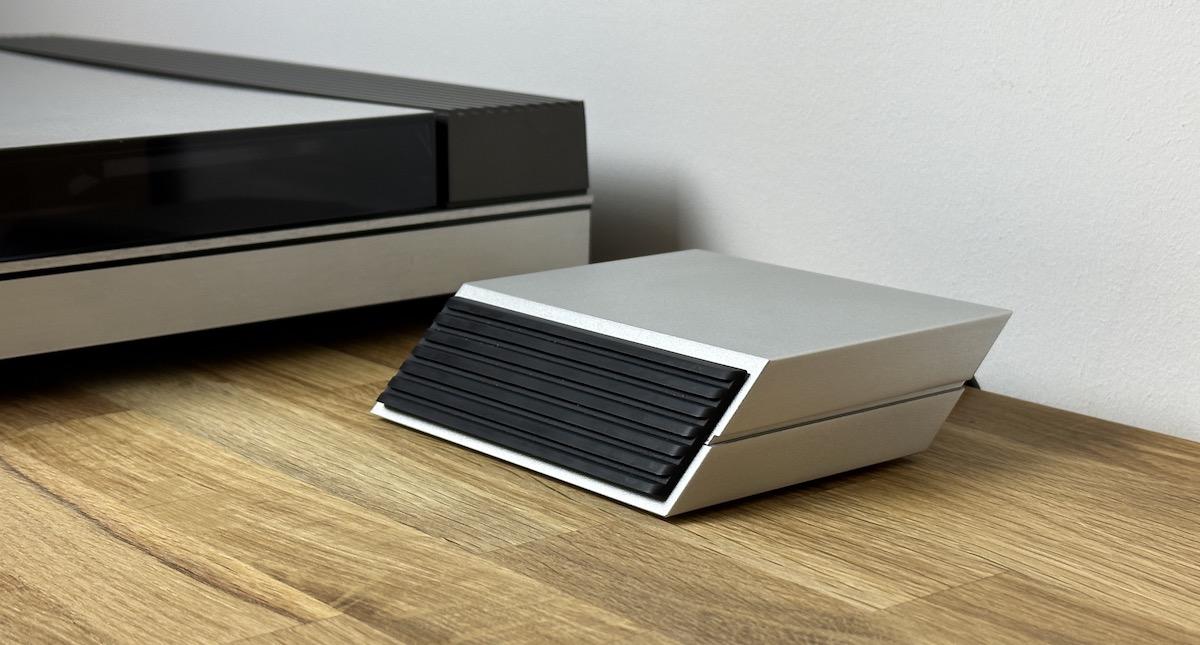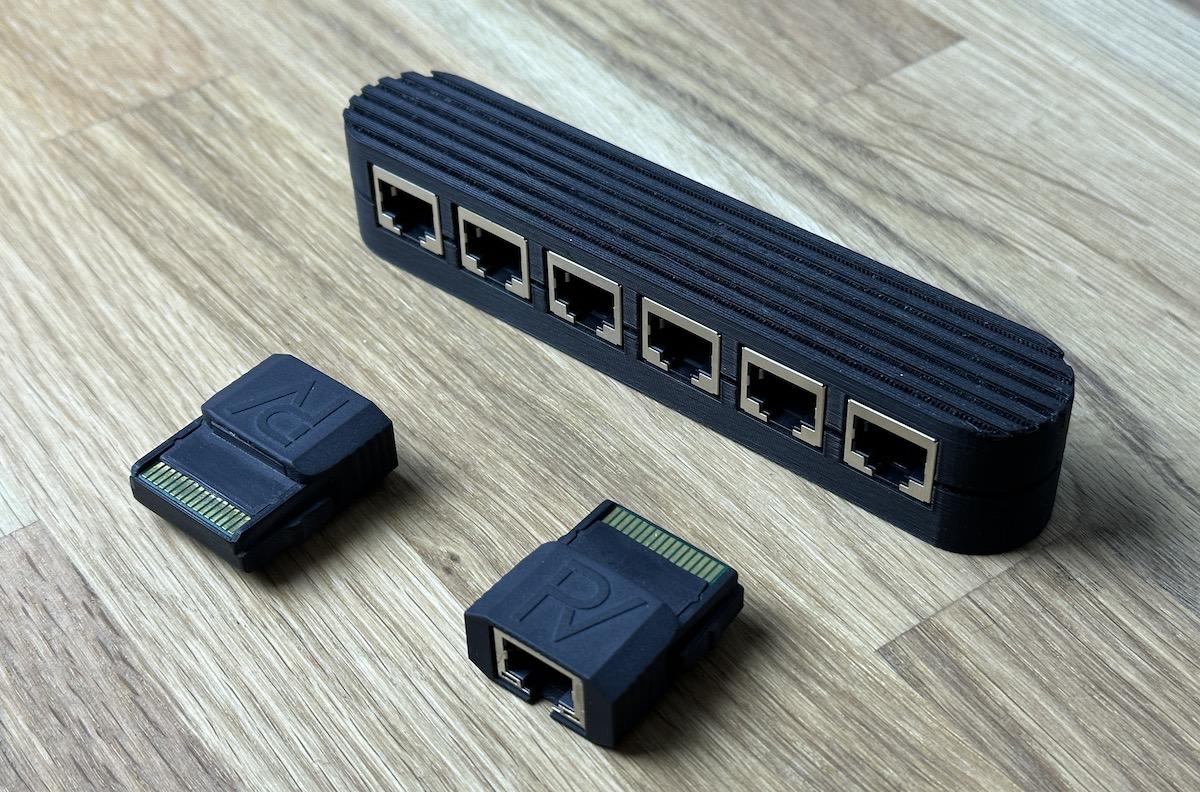Home › Forums › The Workbench › Universal Link Adapter
- This topic has 68 replies, 8 voices, and was last updated 5 months, 4 weeks ago by
 Steve at Sounds Heavenly.
Steve at Sounds Heavenly.
-
AuthorPosts
-
11 October 2023 at 22:14 #2607
Dear Beoworld
This one has been in my head for a couple of years now but I never really had the time taking care of it. Well, I finally pulled the trigger. So let me introduce the Universal (Beo)Link Adapter.
A device completely developed from scratch that lets you directly interface classic B&O products with any modern device.
It connects to any MasterLink or DataLink product. BeoSounds, BeoCenters, BeoGrams, BeoVisions, etc.
It lets you control any DL or ML device and either redistribute its analog audio output to modern AirPlay based speakers – or the other way around.
Possibilities are almost endless. It even has a bypassable RIAA preamp built-in as we all know that there are DL turntables with and without RIAA.
It can act as a ML master or slave, can record ML audio or inject it.
It will talk to e.g. a BeoGram 5500 using the earlier DL protocol, while it can also talk to e.g. a BeoCenter 9500 using the later DL one. Pretty cool controlling a tangential turntable from your phone… 🙂
Decoding and re-implementing the old DL and ML communication protocols was quite a journey – but a fun one!
Design classics like a BeoSystem 7000 or a BeoSound 9000 can suddenly be controlled by a simple webapp and their audio output is magically distributed to any modern AirPlay based speaker – or your normal webbrowser. Even to multiple endpoints at the same time and in sync of course.
Haha, didn’t even stop there. Created a replacement for the ML plug as well. The result is a compact RJ45 <-> ML adapter.
I think this project can be called successful. Both visual and functional. Of course I’m interested in hearing your opinions on it.
Currently there is no commercial intent. It’s a one-off build as a showcase project and for personal use – literally “because why not”.
If you want to read a bit more about the project, have a look here:
The Universal Link AdapterIf you have questions, let me know.
Just don’t compare it with the discontinued NL/ML BCL. At best the BLC has half the functionality of the Universal Link Adapter and it can’t do such cool things like sending the audio of a BeoSound 9000 to a BeoLit 12, Sonos speakers or HomePods… 😉
Cheers,
Philip.


 12 October 2023 at 11:20 #21619
12 October 2023 at 11:20 #21619Hi,
Thanks for your reply, yes this is a current Molex part and type approvals are already in place for it. I see from your website that the B&O flagship store in Berlin financed the project? That seems like a lot of commitment for them if this is your own personal project…are you or B&O Berlin looking to offer these to other B&O owners in the future? I could certainly be interested!
Kind regards, Steve.
12 October 2023 at 11:51 #21618Hi Steve,
Interesting. I tried finding it (the female socket, not the plug) but was unable to do so. Anyway, the RJ45 connector saves a lot of real estate on the PCB. So not a bad choice I guess. In the end there are also those official RJ45 <-> ML adapter cables available. Probably got carried away to quickly because I enjoyed making that small plug adapter. 😉
Thanks for the hint, will update the post accordingly.No, they did not finance it at all! They liked the project idea and lend out some recent network speakers plus a Halo and helped a bit with testing. That’s all. Probably I also should indicate that a bit better there.
It is not completely out of question that this project is ever being commercialised. I never though about that the first place. Just wanted to build that thing for at least 10 years out of a personal desire. As an extra it’s a nice project to show on the website which is missing such work examples.
12 October 2023 at 15:43 #21611Philip,
IMHO, this is the coolest thing that has been posted here in quite a while! I’m undoubtedly biased since your project aligns with many of my interests and projects.
I have many questions about what you have done so far. I will be watching this thread closely to see the level of information detail that you are willing to share.
Would you elaborate on the connectivity to the non-B&O world? Which specific “use cases” are you currently supporting?
Glitch
p.s. I fully understand how challenging it can be to find the female/board side connectors. I’ve run into a similar situation where a seemingly common connector is unobtainable new. In my case, I ended up salvaging the necessary connectors from used equipment.
12 October 2023 at 18:22 #21599Glitch,
thanks for the praise 🙂
Audio wise the “non-B&O world” currently can be served either by the AirPlay protocol or by a html webstream. For both I’m using a really nice open source software called owntone.
For the control part there is a simple html5 webapp that can be easily added to the homescreen of your smartphone. One can select all ML or DL sources from there and direct it to the desired output device.
There are many scenarios that are tested in hardware but not implemented in software yet. It could e.g. act as a “source center” and handle N.Radio and N.Music requests on the ML bus. So for example on an incoming AirPlay stream from your smartphone it could automatically switch on the audio master and inject the music stream accordingly.
Also it can map many functions to custom buttons on a BR Halo. So that one does not depend on the webapp only. It was implemented using the public available Halo python library.
14 October 2023 at 10:27 #21581Since you have the experience, could you tell use how difficult it would be and if you have any insight on why this is something that never came up?
Happy that you like it 🙂
I think there are commercial software solutions available that can act as a airplay sender. For example the one for Windows that can send audio to any airplay enabled speaker. It probably is neither approved nor an official implementation. Also that open source application I’m using here is around for a pretty long time already.
Why such a product was never a thing – I really don’t know. Of course a “big player” can’t use that at all in an official product. But why niche businesses never came up with that…How difficult it would be? Technical wise it entirely depends on the point of view. What I consider easy could be difficult for others and visa verse. So hard to make a statement on that one.
As with every product the difficulty lies mostly one the financial risk. Nowadays the usual go-to-market duties besides the development itself can leave a huge hole in your pockets. Especially when sold internationally it can easily screw up your whole product pricing if you are not selling it in large numbers. Not even to mention customer support and marketing.It is hard for me to say anything to the presented project….other than that it is cool! Lots of respect for that!
Thanks for that, MM 🙂
Also see the explanation above. Me speaking as a company – we are not set up for selling products to end-customers. Been there already, got the t-shirt, didn’t make much sense.
I really wanted to build that thing for a long time and the project was then released on the website to show an example of how we are working. So to at least mentally justify a bit of the effort that went into it.
So for sure the project itself has some kind of marketing idea attached – but not for anything happening here. Just wanted to share it because I think it’s cool to show.Happy to answer any technical questions.
14 October 2023 at 17:47 #21566given that the maker of these products was more or less banned from this forum.
If I remember correctly, the maker of this product was openly advertising for his product to be sold without kindly asking to the forum runners. Absolutely nothing to do with this unless it would be an underground noise with B3OHACK3R selling his box under the hood in PM, which I doubt.
15 October 2023 at 20:50 #21541Stunning result you have here, congratulations !
I am very curious about that enclosure ! Is that something you designed ? Or is it an off the shelf part ?
Full disclosure here, I have an ongoing project that bears some resemblance with yours, but I have already settled on an more conventional enclosure.
18 October 2023 at 03:35 #21505Fascinating product. It’s hard to say how big of a market something like this would have given the vintage nature of its application. But I’d certainly be interested personally. I have an older Beogram and a Beosound 9000 that I believe could employ this.
Open sourcing it or having a distributor for it would be an interesting development.
18 October 2023 at 08:25 #21500Open sourcing the whole thing would not be that much useful. For the average DIY people it will be much too difficult to build – mostly because of the processor part.
Given the risk of low sales numbers – making a regular product out of that would result in being somewhat on the “expensive” side. Probably more than the devices it can control are worth on the 2nd hand market nowadays.
Probably not a huge issue if it would be an original beo product. Nevertheless in the end it would be a 3rd party unit and as matador wrote a few days ago I also see this as a critical point.23 October 2023 at 10:13 #21395Had some more thoughts about this one.
What could probably work out is developing a light version sold as a semi-finished kit to DIY people.
So just the ML and DL interface with a single USB connection for power, audio and data.Anybody interested in that?
Happy to donate a certain amount to beoworld for every unity sold or something similar.23 October 2023 at 15:02 #21391That sounds interesting. Which use cases could this scaled version be used for please? Is there a web interface or app that would allow to control ML or Datalink audio systems via WiFi and to stream these audio sources via AirPlay (there will not be a network RJ45 connection?)
Beyond a missing RIIA preamplifier which other functions will be missing from the light version?
I would be interested in further integration of new and legacy products, just not sure what new features and use cases it will bring (as a light version).
23 October 2023 at 16:57 #21388That sounds interesting. Which use cases could this scaled version be used for please? Is there a web interface or app that would allow to control ML or Datalink audio systems via WiFi and to stream these audio sources via AirPlay (there will not be a network RJ45 connection?) Beyond a missing RIIA preamplifier which other functions will be missing from the light version?
Probably similar to that old PC2 interface. No direct network connection or streaming – the host system needs to take care of that.
A possible “light” version would cut away the processor including the network interface as well as the nice housing.
Maybe leaving the RIAA integrated makes a lot of sense. Probably better splitting it up in a dedicated DL and a dedicated ML version. Both at the same time isn’t necessary anyway.Technically it would still be capable of the same functions like mentioned for the “full” version. Just not fully integrated. The end user would be required soldering some connectors, putting it in a standard housing and setting up the software. Could supply some software examples how certain things can be done…
23 October 2023 at 17:27 #21386First of all very interesting project even though it might not become more than what it is now.
Some use cases for a light version from the top of my head:
- as an interface to activate a Beolab 2000/3500 or Beolink Active when sound is detected from analog audio input (Airport Express, Chromecast audio etc.) That said this already exist as a product from Almando.
- As an interface for controlling and relaying sound from a Beogram/Beogram CD/Beocord to an airplay/chromecast device
Probably better splitting it up in a dedicated DL and a dedicated ML version. Both at the same time isn’t necessary anyway.
One use case for both DL and ML could be to actually control a Beogram from a Masterlink only product (BS Ouverture, BC2, BS4, BS5 and Beovisions with ML). Would probably need the use of some alternative source commands to make this work,
23 October 2023 at 20:13 #21372I could be wrong. Maybe I mixed up something regarding that.
Indeed the two protocols are pretty different. Sometimes they are also referred to Datalink ’80 and Datalink ’86.
The first generation is used for talking to the Beogram / Beocord peripherals. Just two identical bytes being sent back and forth.
Data pins of the TP2 and the Phono are always connected in parallel. I guess two or maybe even more bits are some kind of simple device address while the other ones are the control command. Haven’t investigated that in depth as it’s simple enough to record and just play back the commands when needed.23 October 2023 at 20:41 #21370True, could be.
Was testing with a BC9500 here. So no CD / TP1 sockets.
Phono and TP2 commands are looking different but could be that Phono / CD and TP1 / TP2 are the same.23 October 2023 at 20:46 #21369Can confirm, currently hacking around with what I believe is the Datalink 86 protocol on my Beosystem 5500 ( so CD / TP / TP2 / PHONO ). TP and TP2 protocol are identical, except that TP2 has no support for running status (to provide the MCP5500 with live display).
CD and PHONO also seems identical, but I haven’t pushed the investigation enough to confirm that.
24 October 2023 at 08:04 #21345I’m idly curious on whether BS5 fails to broadcast this information to ML, or perhaps BLC NL/ML strips our the data, or is it the B&O app that ignores the data (if available) and simply displays an inane “Playing from N.Music”, etc. TIA,
Yes, I can confirm that BS5 broadcasts track and station info to ML by default. Must be the BLC / NL side that does not take care of that.
24 October 2023 at 15:27 #21341True, thought about this one as well. Not exactly sure if I remember correctly but couldn’t you just use a 1611 converter for using a turntable in a ML setup (Phono / N.Radio source)?Not as far as I know. In all my testing with the 1611 converter it was not possible to control a Beocord (I have never tested with a Beogram, but will try that soon) directly connected to the 1611For good measure I just did a test with a Beogram 2000 connected to the AAL connector on a 1611 converter, and a Masterlink cable to a Beolab 3500.As expected the Beogram did not react to any audio commands sent to the Beolab 3500.24 October 2023 at 22:02 #21330For good measure I just did a test with a Beogram 2000 connected to the AAL connector on a 1611 converter, and a Masterlink cable to a Beolab 3500.As expected the Beogram did not react to any audio commands sent to the Beolab 3500.Ah, great. Thanks for testing. Indeed I must have mixed up something then. So the 1611 cannot switch between the two different datalink protocols. -
AuthorPosts
- You must be logged in to reply to this topic.



